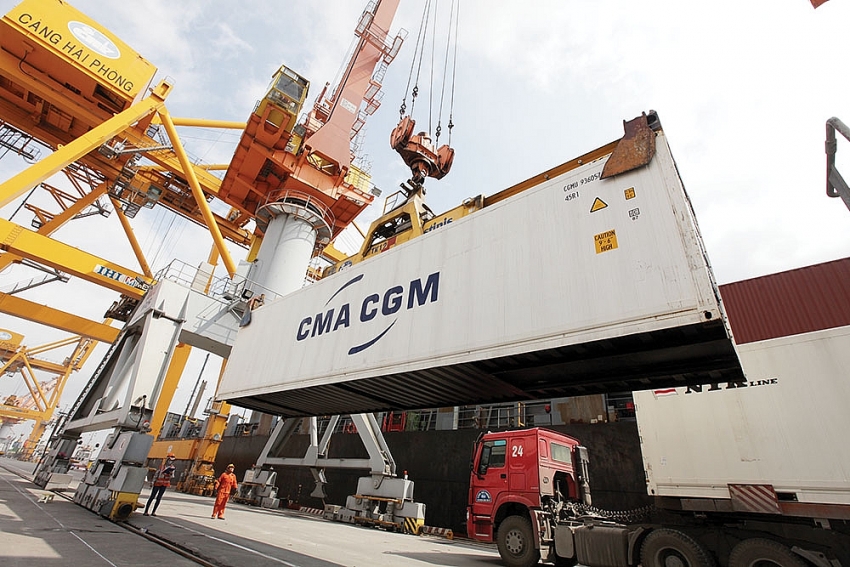Enterprises risk losing export markets due to ocean freight cost
 |
| Vietnam’s key goods face the risk of losing export markets due to high ocean freight cost |
SSI Research has issued a pessimistic forecast for Vinh Hoan Seafood JSC’s (VHC) business results in the second half of this year, after meeting with the leaders of this company.
“Since global ocean freight costs started to increase last October, VHC had to sign more CIF orders – meaning that they had to cover the shipping costs – to maintain relationships with traditional partners. This also means that the company now bears most of the freight charges and related risks,” stated SSI Research.
“Although the management is working hard to negotiate with partners for more FOB orders – in which buyers pay for shipping – for the contracts signed in October, the freight costs remain high and discouraging.”
According to VHC’s leadership, demand for its products or supply of raw materials are no issues. The orders from the US are increasing, and the company is maintaining operation with the stay-at-work model, with 65 per cent of its usual workforce stationed at the company. The main problem lies in exporting goods overseas as shipping charges climbed sky high due to a shortage of empty containers and the increased demand for freight.
Statistics of the General Department of Customs show that after the growth momentum in the first half of this year, in July, the export turnover of the seafood sector decreased by 4 per cent on-year.
In the first half of August, seafood exports reached a turnover of $264 million, down 41 per cent compared to the second half of July and down 30 per cent on-year. In which, basa exports fell by more than 30 per cent on-year.
The situation means that enterprises practically export goods with zero profit, even accepting losses to keep the relationships with traditional partners. On average, around 95 per cent of seafood goods from Vietnam are exported via seaway.
Thai Nhu Hiep, director of Vinh Hiep Co., Ltd. – the company that exported the first batch of coffee to Belgium and Germany under the trade agreement with the EU – told VIR, “At present, we have to accept exporting with little profit, sometimes even with losses. We have to ensure our credibility with foreign partners. Enterprises like us are forced to take advantage of all legal ways to export their goods overseas if they do not want customers to cancel the orders. There will be no compromise or sympathy from foreign partners for delays in completing contracts. However, only large-scale companies have the ability to maintain this situation. It is an impossible mission for small- and medium-sized enterprises,” Hiep said.
Despite many enterprises trying their best to export goods smoothly, their concerns about losing the export markets remains. Nguyen Dinh Tung, CEO of Vina T&T Co., Ltd. – which specialises in exporting fruit to the US, Australia, and Canada – said that many firms are struggling to export their goods and partially had to suspend operations. Some of them also face competition and may lose their business to foreign competitors.
According to the Vietnam Pepper Association’s (APV) observation, enterprises in the US and EU are increasing their orders for pepper products from Brazil because its quality is not too different compared to Vietnam’s products, while freight costs from Brazil to the US are only one-third of that from Vietnam. Besides this, the charges from Brazil to the EU amount to only one-tenth of that from Vietnam.
The APV forecast that if the increase in ocean freight costs does not cease soon, Vietnam’s pepper industry may completely its capacity in the US and EU markets. Similarly, other agricultural goods could also lose their market shares overseas.
In mid-August, SSI Research forecast that freight rates may peak in the fourth quarter of 2021, only declining slightly in the first half of 2022.
“Freight cost may see a significant decrease in 2023, when the supply of new ships rises, but the charges will still maintain a higher level than before the pandemic,” SSI Research stated.
What the stars mean:
★ Poor ★ ★ Promising ★★★ Good ★★★★ Very good ★★★★★ Exceptional
Related Contents
Latest News
More News
- Businesses ramp up production as year-end orders surge (December 30, 2025 | 10:05)
- Vietjet chairwoman awarded Labour Hero title (December 29, 2025 | 13:06)
- How to unlock ESG value through green innovation (December 29, 2025 | 10:03)
- AI reshapes media and advertising industry (December 29, 2025 | 08:33)
- FPT and GELEX sign deal to develop blockchain tech for global markets (December 29, 2025 | 08:29)
- Vietnam’s GDP forecast to grow by 9 per cent in 2026 (December 29, 2025 | 08:29)
- Women entrepreneurs are key to Vietnam’s economic growth (December 29, 2025 | 08:00)
- Vietnam's top 500 value-creating enterprises announced (December 27, 2025 | 08:00)
- The PAN Group shaping a better future with ESG strategy (December 26, 2025 | 09:00)
- Masan Consumer officially lists on HSX, marking the next phase of value creation (December 25, 2025 | 13:20)

 Tag:
Tag:



























 Mobile Version
Mobile Version